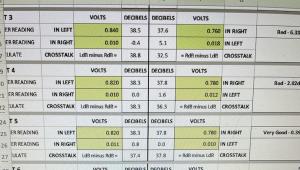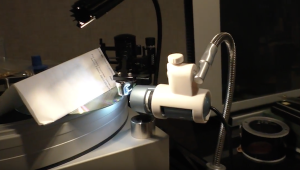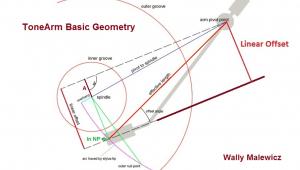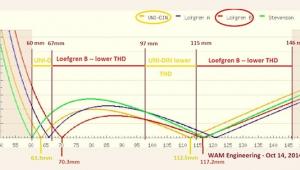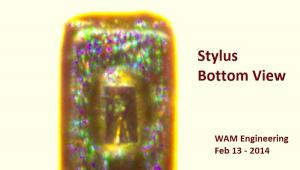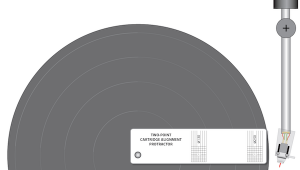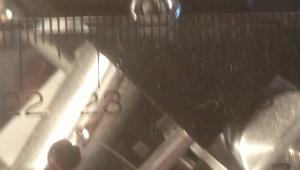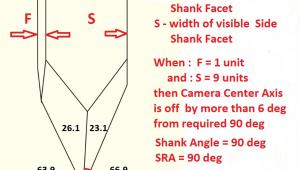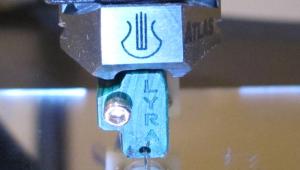But I am not understanding this description. The Fozgo is connected to the phono leads or phono preamp. How does playing a track on a CD or iPod move the needle on the unit? Is there something I am missing?
Fozgometer Owner Alert !

I switched because the Fozgometer's results were not at all accurate and until just the other day I did know know there's a way to calibrate the Fozgometer. The instructions are on the Musical Surroundings website.
With the unit "off" using a small screwdriver you adjust the meter to read "0" by turning the black adjustment screw at the bottom of the meter. Then remove the unit from the case.
On another page on the Musical Surroundings website you'll find three test tones available as aif and wav files. While the instructions recommend downloading and burning a CD, you really don't have to do that if you have a stereo mini plug to RCA plug cable, which many of you probably have to connect an iPod or other such device to the inputs of a receiver. If you have that and a mini-jack on your laptop you are all set (otherwise download the tones and burn to a CD-R).
First remove the Fozgometer from the case by removing the fur Philips screws. Turn on the Fozgometer and note on the right side attached to the circuit board (when viewing the unit with the meter at the bottom) a small set screw in a blue plastic housing. Play Track One and adjust the set screw until the meter points to ZERO (only the green LED will light while you do this).
Play the second test tone and adjust the other set screw on the left side of the printed circuit board until the meter reads 20dB (only the right red LED will light).
Next play the third test tone. The meter should again read 20dB with the left red LED lighting.
If you don't get exactly 20dB repeat the calibration until you do.
After doing this I used the Fozgometer as described in the instructions and using the Analogue Productions The Ultimate Analogue Test LP I obtained readings that matched what I obtained using the digital oscilloscope.
My Fozgometer was way out of calibration and was probably so when I first got it. Now I feel it is a reliable tool to use for setting azimuth. Thanks to turntable set-up expert Michael Trei for alerting me to this.
- Log in or register to post comments


Hi Michael,
Old thread - sorry - but I decided I should re-calibrate my Fozgometer today. I have the 3 test files (which I'm playing straight from my laptop into my Fozgometer) but I can't get the meter to read 20dB on the Left channel (with the 3rd Test track). It does read 20dB on the Right channel, using the 2nd Test track.
The instructions say "repeat the calibration" if you can't get the Left test to read 20dB ... I've done this and always get the same result:
* I can set the Right channel to 20dB, using Test track #2
* but the Left channel reads about 18dB! :-((
Can you tell me what I can do? Or does it seem my Fozgometer has broken?
Thanks,
Andy

I was going to use mine this weekend but your instructions were unclear. I checked those in the Foz box and that made sense. You saved me another unfruitful bout with the VPI 3D arm.

I will recalibrate this weekend. Mikey---you are an invaluable asset to analog lovers.

Several years ago I set up my new TT manually and checked my results a new Fozgometer, according to it I was a 1/2 db. off at around 26 or 27 db. separation. Another look is long overdue.


I wouldn't mind seeing a short write up on how to set azimuth using the digital oscilloscope method. With a decent soundcard, there is a lot of excellent software that doesn't cost much.

Second that thought. Seems like with a little looking around the old internet oscilloscopes can be found at prices pretty close to the cost of the Foz or Adjust+.

Same here--let's hear how to do it. There is even a freeware oscilloscope program out there, and all you need to do is get the audio into your computer. For test tones, you probably don't need to go all audiophile on it. The same should apply to a "real" oscilloscope as well. I know there are ways to do alignment by listening, but I prefer seeing what I'm measuring.

Measuring azimuth with a oscilloscope is the only good way of measuring it because you can see what you're measuring. I wanted to react already a long time on the azimuth issue. Setting azimuth correctly is KEY to a good record player set-up! I can't emphases it enough. Using a digital multimeter is no good either. The problem with the device above is that there is always a parallaxes error (if one looks to a different angle towards the needle, the measured result will differ) that's why panel meters are usually equipped with a mirror at the scale. But any way, if you're serious about setting up the record player, by a simple digital oscilloscope. They are cheap these days (RIGOL). I did the measurement on my set-up and the results are very satisfying: channel separation of 36,4dB R, 37dB L spec from the cartridge manufacturer >35dB off course measured at 1kHz.

I don't use a Fozmeter. First of all, I don't know how to use an Oscilloscope so there would have to be something with instructions. Second, just how inexpensive are they? I just looked at RIGOL and I see four digits everywhere.
I tend to use my ears because I have legacy tables and prefer them, no unipivot arms. (Not that those are bad, I just don't have one). I just set tracking, antiskate, alignment with a custom arc protractor and check the angle mount with a lined index card. (I don't know how to fix that either if it is ever off and so far I've been lucky...I think). Then I triple check everything again of course.
So far I've heard no issues, nothing sounds off, but who knows.
I think I need a good soundcard if the scope is to be used with a computer. I don't have a good soundcard except on my desktop.

that's a lot of money to pay for an instrument that's not calibrated at the factory. I can see having to do it after owning one for a few years, but right out of the box?

I didn't take mine apart, wanted to check it as is. It sits at 0 with the unit turned off or on. Track one, needle did not budge one iota. Tracks two and three are the exact same, but mine reads 18 and not 20. This is at 60% volume. At 100% volume both tracks read 17. Do you think this unit needs adjustment? I connected it directly to my laptop with an integrated (read inferior) soundcard. I wonder if the signal out of my laptop is an exact 1kHz as it changes under different volumes, I'm not sure.
Regarding a Fozgometer being way off from the factory, like any instrument that measures something and uses a dial, if the box it is shipped in has been treated roughly (and that is most of the time) that could throw it off.

All three tracks are an exact 1kHz.

At 25% (Windows) volume, both tracks two and three read 20. I think the higher volumes might just be overloading the Foz, the lower I set it the more accurate the results. It reads directly off my .5 mV cartridge just fine. Any insight into this?
Micheal, do you have any idea what the OS volume should be adjusted to and what is/was yours adjusted to when you calibrated the unit?

"stereo mini plug to RCA plug cable" approach failed totally. Wrong LEDs and levels. Burned CD and calibration was close to spot on.
No idea if sketchy sound card or miss-wired mini to RCA cable accounts for fail.

I think if you test one chanel and then repeat the test using the same test track but reversing the leads at the meter might also be a valid method of checking calibration. I may try it out tonight.

Thank you to Mr. Fremer for his post about the Fozgometer. Well over 2000 Fozgometers have been sold since its introduction at the end of 2009. As Mr. Fremer states, it is a "reliable tool to use for setting azimuth". The Fozgometer provides incredibly accurate results if used correctly. New Fozgometer units require no calibration, as they are checked at the factory as well as at Musical Surroundings prior to shipping. Because it is a very sensitive device which runs on an internal 9V battery, it is critical that the voltage output of the battery remain constant. A battery can lose voltage over time, thus the accuracy of the Fozgometer can be affected. Understanding this, we have provided calibration tones and procedures on our website since the Fozgometer was introduced over 5 years ago. Mr. Fremer received his Fozgometer in January 2010 and positively reviewed it in Stereophile.
If your Fozgometer is over a year old, please check and replace the battery if needed as it is important that a fresh battery be installed prior to calibration and use. If a user is unsure or would like to double check the calibration, Musical Surroundings or your Fozgometer dealer can offer direct assistance.
Garth Leerer
President

Contrary to Mr. Leerer's advice I believe it is worthwhile to take the time and check the calibration on even a newly acquired Fozgometer. As others have pointed out, during shipping it can get out of adjustment.
Case in point, I purchased a Fozgometer a couple weeks ago and immediately put it to work adjusting my VPI Classic 3 tonearm w/ Dynavector 20X2H cart using the Ultimate Analogue Test LP. To get a good reading I had to adjust the arm to the point where the cartridge shell was tilted 'spindle-ward' by a good 15 degrees.
After re-reading all the literature and locating the calibration instructions, I downloaded the tracks to my pc and burned a CD. Calibration took just a few minutes, but as an engineer I was particular about re-running the entire process several times until I had the dial zeroed in as closely as possible.
Unfortunately, even after the calibration my head shell and cartridge were still tilted a good 10 - 15 degrees. I finally gave up and leveled the cartridge by eyeball (tip: use your cellphone to take a photo so you don't have to deal with keeping your eye steady while lining up to your reference marks).
I've heard great things about the Fozgometer and suspect my cartridge may simply have higher than expected crosstalk. Using this device isn't rocket science so I don't THINK I simply screwed up the measurement process. OK, maybe this wasn't a good 'case in point'!

15 degrees seems way out of spec for a cartridge... IMHO

No, this comment hasn'y much to do with the Foz thread, in itself. But I've just come from the Web, checking out recent reviews of Neil Young's nano, having just completed reading JA's in Stereophile. And all I can say: Are we all properly grateful to Mikey for his analogplanet.com? Because we should be! Here, in this special place, we can all converse reasonably without fearing idiotic and obscene insults being hurled at us. Instead, we can discuss what we all enjoy, vinyl recordings, without fear of encountering hatred and venomous ignorance. Why, in this space today Mikey himself admits his past ignorance in order to suggest ways we all can learn from his mistake and profit by it. Unthinkable on those other Websites, supposedly devoted to audio, that I've seen today! So, thanks, Mikey, for all your hard work. We all owe you, big time!!

Like R. Cook, when I used my Fozgometer to adjust azimuth, my headship needed to be adjusted a good 15 degrees towards the spindle before the meter represented a reading that matched both left and right channels i didn't feel comfortable with this reading and decided to make the adjustments visual.
Glad to read I'm not the only one who experienced this issue. As much as I want to trust this meter, I can't.

How did it sound "adjusted"?

That is a lot of degrees. You trust your cartridge is not the culprit? Damaged, dirty, not built to spec?

If anyone wants to sell their Fozgometer, I've been looking for one for quiet a while.
Best,
Z

There are those who might have issues with their Foz... I can't stress enough that a brand new battery is recommended. Also, the meter extends far back in its case and may touch the metal case and ground out. Install electrical tape on the connections, or the case to remedy this.

Many thanks for posting on this issue, and providing the fix! With a little effort i was able to calibrate my Fozgo, and reset my azimuth with left channel signal at 30 (dead on and stable), and the right somewhere between 30 and one "tick" past 30 (which i'm guessing is about 30.5). Good enough! However, the Channel balance favors the left with a signal level of ~2.5. Is that "typical"? Sounds fine to me. Thanks again!

if i could get my SRA at 92 degrees without having my tonearm hiked up to its max height, i'd sleep even better at night. Seriously though, I really appreciate this owner alert - thank you! Thanks also to Peter Ledermann for doing such a nice job on the re-tip of my cartridge (Sumiko Blackbird) - seems i ought to leave good enough alone at this point.

Mikey, I'm surprised someone as geeky about setup would just now learn that the Foz needed calibration. Don't say you're not geeky, I've read countless articles where you describe in detail how carts are made. I bought mine at the same time I purchased my Graham Phantom and was given a really good deal, so I was happy. Being just as picky about setup myself, I second the request for a technical how to on using an oscilloscope. I have an analog oscilloscope. Am I correct in assuming it has to be digital?

Did you repeat the calibration with the inputs to the Foz reversed (and of course swapping track 2 and track 3 in the procedure) and not have to make any adjustments? Or you previously calibrated (trimmed) the output balance from the soundcard? Calibrating an instrument with a noncalibrated source defies the concept of calibration.

I do not have a Fozgometer.
I have an HP400E AC Voltmeter, lowest range on meter is .001 volt AC to 300 volt. The lowest setting is 1 millivolt at full scale. I also have a Heath 1274 signal/sweep generator (2 to 2 Mhz) for injecting a signal into any device, (not a cartridge) phone preamp, or cable for conditioning.
I also have 4 test records, the Hifi News test record is my favorite.
I worked in an Electronics lab for years as a young man, so experience with test equipment is a knowledge I have.
Summary of my testing, some cartridges are badly aligned and or have uneven or unmatched signal outputs due to coil mismatch.
The Fozgate meter measures each channel individually and you read the output. I do the same with my HP AC meter, one channel at a time.
The goal is equal output in both channels.
When I get a cartridge that is not equal, I no longer attempt to get equal output, I go for the highest output on each channel, Hoping that the other channel is also at it's peak output. it is all a compromise, it is analog. My goal is to get the clearest signal on the left and well as the right. i am OK with the a little higher output in one channel or the other.
The Fozgometer is a great device, If you think it it is off, use a single channel for the measurements to quick verification. If your cartridge needs to be tilted 15 degrees to get equal output, it was poorly mounted or has unmatched coils. Adjust for the highest output in each channel and find a compromise or get a cartridge that is correctly mounted and has equal coils.

http://www.audioasylum.com/cgi/t.mpl?f=vinyl&m=138751
Great read on Cartridge crosstalk and azimuth.

Most of my cartridges are not balanced. This can only be seen with test equipment. Nice thing about a Oscope, you see the signal.
If you used an Oscilloscope and view both channels concurrently with a mono signal on a channel. You will see that the crosstalk is lowest on the non signal channel at the highest output on the channel with the signal applied. Do not read the signal via the phono preamp, they too are imbalanced.
I focus on a single channel looking for the highest output and the lowest crosstalk. I record that and than do the second channel. I now have a reference for both channels. Using that info, I do the final adjustment. I am looking for the best signal not channel balance.
A phono cartridge is what it is, a hand made signal retriever with flaws.

I believe a McIntosh Maximum Performance Indicator (MPI3 or MPI4) will serve as an oscilloscope for this purpose.

I wonder if anyone else has had this experience? From its first use, my "Fozgometer" has given completely crazy, contradictory, and obviously incorrect readings. So naturally, I was pleased to read this post.
I immediately changed the battery and confirmed that it was indeed (theoretically) calibrated. I ran an azimuth test using my "Ultimate Analogue Test LP". Now, with the headshell visually level, one channel is at about "20", and the other blasts right off the meter past "40". By adjusting the headshell to the left so that the stylus is practically facing the ceiling, I can get the readings within 10 units of each other. Of course I can do the same thing by adusting it at a similarly crazy angle in the other direction.
As for me, I'm out of money at the moment...so until I can afford the diamond-encrusted electron microscope, looks like I'll be judging by ear :-)

that upon receiving mine years ago, (I read the instructions) that explained how to calibrate the unit.
My memory is a little foggy on an issue I had but if I remember correctly, the meter would never go completely to zero while in the calibration mode. I contacted my dealer who really didn't have an answer. I then emailed Musical Surroundings and I believe I was questioned as to why I would want/need to calibrate a new unit. I will say based on listening, the unit seems to work fine. Would Musical Surroundings entertain trading in an old unit for a new one that never needs calibration?

I was setting up a new Urishi yesterday and used the Fozgometer. I checked the calibration and it was off. About like I see when adjusting a vintage tape deck. I replaced the battery first and it was still off. I calibrated it following the directions and it was stable and repeatable. I then used it to set up the azimuth on my Basis Vector and I achieved excellent results. I do have a duel trace Tectronix scope but I felt I was getting a excellent result with the calibrated Fozgometer. Thanks again for the heads up!!
Ken

Would you care to share your tt/arm? I've had a similar issue in my past.

I use a Basis Vector with a Basis Debut Gold Vac with a Walker Motor Drive. I find the Vector difficult to adjust the azimuth. Hell I find its difficult to adjust the arm period! But I do love the arm.
Ken

either of those tables/arms. Mine was a VPI MkIV/ET 2.5. I found that part of my particular issue had to do with the overall less than perfect machining of the table/armboard and their relationships to one another when measuring (level) at just one point... say the plinth. Since the top surface of the plinth wasn't perfectly level, the bearing is slightly off, then the platter, then the armboard. A never ending comedy of errors.
A thought... it may have something to do with the wiring of your cartridge or maybe even the stylus, if it isn't affixed in a perfect square relationship to the cantilever.

I've been working through this myself recently and finding a rather steep angle, I calculated around 7 degrees! I have followed and used the calibration. It is very easy to do, I use my iPhone with a Cardas mini headphone jack to two RCA plugs. I book mark the link to Musical Surroundings provided by Mr. Fremer and I just hit play! Right into the Fozgometer. Over 6 months I have checked it 5 or 6 times and it has remained right where I left it!
My settings were unfortunately around 7 degrees with the high side toward the spindle. I was uncomfortable with the results and set the cartridge up parallel with just listening. I've played with it a number of times but it always ended up the same crazy 7 degrees or so. I'd continue to do more reading and no one really had an answer. The cartridge tip looked fine under the microscope.
Just recently I decide to give it another try. I had re-read the instructions carefully and noticed it said not to chase the highest DB reading only minimize the difference in the readings. Starting from Parallel I worked at it very slowly and with very minor changes. Quite quickly I over shot needing to tilt back the other way. The DB is at a much lower reading however just off parallel i was able to zero the cartridge in at a much smaller angle. Listening told me what I found was correct!
So those finding their cartridges off at a high angle may, like me, have been chasing a higher DB reading and zeroing out there instead of zeroing out around parallel at a lower DB reading.

FWIW an easy way to level a tonearm is by using a mason's (or carpenter's) line level. They are about 3.5 inches long, weigh a few grams, and made of black plastic with a provision to hang it from a string line on one side, and the ability to set it on a curved surface on the other. Can be bought at any good hardware store for about $2. Just set the non hanger side on the tone arm and level it...you might want to use a small piece of tape to keep it from shifting as you adjust.

Downloaded the test tones and analysed them in Adobe Audition - track 2 and 3, the left and right tracks aren't equal... one track is about 2dB below the other. Is this deliberate? Significant? I rebalanced them before using for calibration...





